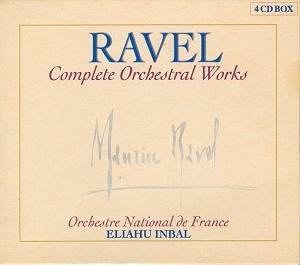This
set is licensed from the Japanese company Denon who made the recordings
in Paris within the first half decade of the CD medium.
Sparkle
and élan are in regrettably short supply in this set although
explosions of sound, when they appear, are shatteringly full.
You can hear both the power and the sleepiness this in Boléro
and Daphnis. While there is a winsome cameo charm
to the Menuet Antique it is a mite lethargic.
In
La Valse, very successfully done, the flutter-tongued
flute volplaning registers strongly pointing up parallels in equally
deserving marine-scape Le Tombeau de Chateaubriand by the
highly-gifted Louis Aubert. La Valse's sauntering pace,
breeze-ruffled gauzes and warm shimmer suggest a waltz that could
be danced; it is at that pace. Other gestures remind me of the
pot plants and chintz of Barber's Souvenirs. Memorable
are the trumpets cutting aggressively through the blurred galloping
pace of last few minutes of the piece.
The
recordings were made by Yoshiharu Kawaguchi who clearly espoused
the then new digital medium for its ability to portray the merest
breath through to stunning ear-assaulting climaxes. Boléro
is the classic example. The principle is a good one but here it
is just too much. Strangely in the well sustained mystery of Alborada
the engineers pull back at the first blast leaching away its impact.
There are some extremely nice touches in this recording: listen
to the atmosphere conjured at 2.46 tr.6.
In
Rapsodie Espagnole Inbal and the orchestra are extremely
imaginative. Listen at 3.43 to that violinistic sliding, slipping
and turning (also at 4.10 in tr.5 CD2)
Inbal's
approach rather suits the Ma mère l'Oie so
if you can imagine and relish this piece at a Delian languid tempo
with summer oozing through the veins then look no further. Some
perhaps many will find this all rather torpid but Inbal does seem
really engaged by the piece and its delicacy is not lost on him
as you can hear in Laideronnette (tr.6 CD3). Perhaps predictably
the 'slow burn' of the Apothéose works extremely
well in all its melancholic triumph.
Le
Tombeau de Couperin is a shade deliberate but as expected
from my comments on the Ma Mère ballet the Pavane
stretches, yawns and purrs elegantly. Not up to Monteux standards
but a far from negligible or insensitive performance. By the way
the two ballets are each given complete rather than in suite form.
Une Barque is a lovely mood picture and works very
well with the little surges at 0.56 suggestive of Bernard Herrmann.
The thunderous and then miniature absurd Fanfare
is a nice makeweight.
Pictures
suffers from the warm languor and flaccidness of other
parts of this set. The sound is well calculated with perspective,
breadth and distancing extremely well conveyed. However this sounds
somnolent even in the Tuileries. Things improve with the
grotesque 'chicks' and Limoges but I still cannot recommend
this strongly - upper low field at best.
Then
come two other shorter Ravel orchestrations, both from 1922, each
of pieces by Debussy. The buoyant and vivacious Danse Styrienne
contrasts with the sunny melancholy of the Sarabande.
The ppp gong stroke at 1.11 has never registered with such
subtle mystery.
The
Valse Nobles et Sentimentales must surely have served
as the model for Barber's Souvenirs suite. Across its eight
short movements this sequence works well with palatably digestible
echoes of La Valse separated by mysterious interludes
If
you are looking for ideal recommendations then opt for Martinon
and the ORTF orchestra in EMI's superb bargain price eight
disc set of the Debussy and Ravel orchestral works - analogue
from circa 1972 but opulently imaginative at every level.
This
is a bargain basement production produced without any notes. Its
coverage is generous, untypically harvesting the Pictures,
an unusually generous step. There are pleasures here for those
favouring the more expansive approach to Ravel. Ma Mère
l'Oie is good as is the Pavane; indeed this is hardly
a disaster. It is simply that Martinon and EMI do everything better.
The overall picture disappoints somewhat. I recommend that you
shop around for the Martinon set or if Ravel is your special interest
then, in their various historic guises, the Monteux (Philips)
or Inghelbrecht (Testament) recently recommended by David Mellor
on Classic FM are bound to please. The Monteux is in very good
sound still. The Testament discs may be too much for the general
listener but for Ravel enthusiasts Inghelbrecht is stunningly
imaginative. I only wish that we could persuade Testament to allow
us to review their material.
Rob
Barnett

